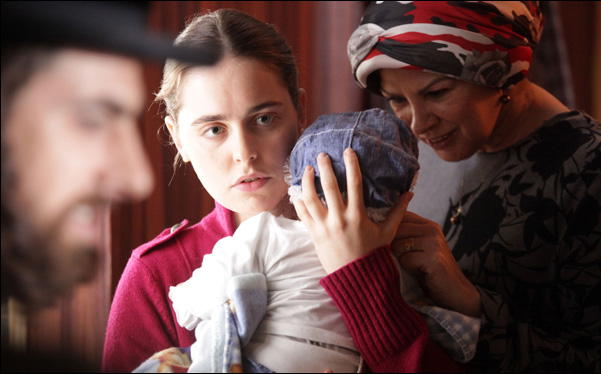In the midst of a crucial scene in “Fill the Void,” an old woman barges into the office of a rabbi weighing a decision that will greatly impact the characters we’ve spent the majority of the film with, yet the woman stubbornly stands in his doorway and ultimately steals the rabbi away for a minute to help fix her oven. That writer/director Rama Burshtein follows the rabbi and the woman upstairs to her apartment while the fate of the film’s characters hangs in the balance is the kind of decision that makes her directorial debut such a pleasant surprise, finding the drama in the small, insular community of orthodox Jews by letting life interrupt their strict routine.
There have been many films already about shidduch, the process of arranging marriages that are part of the religion, but few have been told from the female perspective. While “Fill the Void” doesn’t exactly pass the Bechdel test, it levels out the balance of power between its male and female counterparts, at least in screen terms, demonstrating such equality in its early going as it passes through the segregated corridors of a Rabbi’s flat during a Purim celebration from the raucous merrymaking of the men in shtreimel fur hats in the dining room to the quieter contemplation of practical concerns of the women in the kitchen.
There is plenty to talk about, since the family’s youngest daughter Shira (Hadas Yaorn) is awaiting word on whether she’ll marry a young man of roughly the same age and social standing. But when a tragedy hits home days later, she learns she may be exchanging vows with someone else out of familial obligation, causing a surge of soul-searching within the Mendelman clan.
What’s most immediately striking about “Fill the Void” is how Burshtein and cinematographer Asaf Sudry flood the film with light giving it a fuzzy, nostalgic feel. But the soft focus belies a sharp observation of the family’s constantly shifting emotional considerations, particularly those of the fragile 18-year-old Shira, and a power dynamic that shifts towards the women in private while the men put on a brave face in public. In any way you want to define it, the film’s strongest role belongs to Irit Sheleg, bringing both ferocity and sensitivity to the Mendelmans’ matriarch Rivka who needs to reconcile her best intentions for Shira’s future with the stealthy maneuvering required to protect the interests of the entire family.
Ironically, that’s to take nothing away from Yaorn as Shira, whose doe-eyed innocence may be a little too obvious and may be left to waffle about resolving the dilemma in front of her for a bit too long, risking the film’s momentum going into the third act. Yet the actress nonetheless can get across great vulnerability in a glance and is afforded many of “Fill the Void”’s best scenes, chief among them when she’s asked to play accordion for a kindergarten class and lets the music speak for her growing heartache.
It’s one of the few moments where she has such freedom as an individual, but for better or worse, Burshtein elides a specific critique of the religious ideology that has forced Shira into marriage in the first place. Instead, she offers up a respectful glimpse of the devout Hassidic community that places the humanity of its members above their beliefs with the film’s central character having no choice but to fit in, even while fighting hard to let her thoughts run free, and by showing a world governed by emotion rather than strictures of faith, Burshtein has brought it closer to the larger one outside in elegant fashion.
“Fill the Void” will play the Sundance Film Festival at the Temple Theatre on January 20th, the Sundance Resort Screening Room on January 21st, the Prospector Square Theater on January 23rd, the Redstone Cinema 2 on January 24th and the Broadway Centre Cinema on January 26th. It will open later this year via Sony Pictures Classics.




